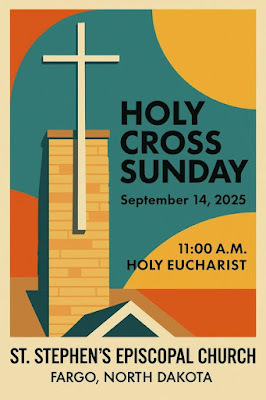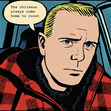Holy Cross

September14, 2025
John 10: 11-16
+ I always say this:
If you come into church and see redparaments—the red altar frontal, the red hangings, the red chasuble—beprepared.
We are commemorating something not sopleasant.
Well, except for Pentecost.
Then, we celebrate the Holy Spirit.
But usually when we have the red up, itmeans we’re dealing with martyrs.
This morning, we have the red on.
But, no, we’re not commemorating amartyr.
But, still, sadly, we are commemoratingsomething not that pleasant either.
This morning we are commemoratingprobably the one most important symbols of who we are as Christians.
We are commemorating the Holy Cross.
The late, great Father John-Julian ofthe Episcopal religious order, the Order of Julian or Norwich, writes aboutthis very important feast in his wonderful book, Stars in a Dark World,which we use regularly at our Wednesday evening Eucharist.
He writes:
“It is noteworthy, I think, to see thatthe Church celebrate the Exaltation of the Holy Cross not with the penitentialpurple of Lent or the mortal black of Good Friday, but with the brilliantpassion red of celebration and honor! And the propers of this feast do notdwell on the bloody death of Christ but rather upon the wonder of the utterlyholy [instrument], because the executioner’s instrument has been exalted as themeans of the salvation of the world. The salvic resurrection of Christtransformed the gross and ugly Cross of death into the most enduring symbol oflife and hope.”
Now, we probably don’t really thinkabout the Cross as an object too often.
We find of take it for granted.
We see it every Sunday.
We see them on the churches we passevery day.
We probably wear the around our necksor hang them on the walls of our homes.
For us, of course, the Cross is morethan just two pieces of wood bound together.
For us the Cross is our symbol.
And more than that.
We have essentially been branded withthe cross.
Each of us were marked by the Cross inour baptism.
And as a result, it is ingrained intoour very souls.
We make the cross very nice and pretty.
But we sometimes forget that it was, inits day, a symbol of execution and death.
You will notice today that we have thisblack, hand-made cross in front of the altar.
This cross was made by my fatherfifteen years ago last April.
He made it for me to use at our GoodFriday liturgy.
Well, if you follow me on social media,you will have seen my post about the fact that fifteen years ago today—on thefeast of the Holy Cross—my father died very suddenly.
Some of you remember that time in thelife of your priest.
And you’ll also remember how it came inthe middle of a string of deaths in our parish—I think we had seven that monthalone.
I always thought it was apt that myfather made the cross we use for Good Friday during his last Holy Week and thatsame year he would die on the feast of Holy Cross.
It’s especially apt, since my fatherknew a few thing about bearing crosses in his own life.
He knew how to endure hardships anddifficulties.
And I am grateful he taught me thatlesson in my own life.
For me this feast day takes on so muchmeaning, but so too does the cross itself.
This symbol of death and degradationhas been given to us and we are told to bear it with all the strength anddignity we can muster, just as Jesus did.
I’ve shared this quote with you before,but I love this saying by Blessed Charles Grafton, the Bishop of Fond Du Lac,Wisconsin.
He said that our job as Christians isto “preach the Cross from the Cross.”
By that, I think, he meant that weshould preach the cross from our own imperfection, our own limitation, our ownbrokenness.
And doing so is not easy.
It is not easy to preach about thissymbol of death when we are surrounded by such death and violence.
In our Gospel reading for today, wehear Jesus say to us,
“Walk while you have the light, so thatthe darkness may not overtake you. If you walk in the darkness, you do not knowwhere you are going. While you have the light, believe in the light, so thatyou may become children of light.”
Those words resonate for us.
We have often felt as though we havebeen overtaken by darkness.
Certainly recently.
I know most of us here this morning followedthe events that happened this week in Utah.
It was ugly.
And that event just proved to all of ushow divided we are, how broken we are.
In the day or so that followed, I likemany of us had to endure some brutal reality about our country, and someterrible ugliness.
And it would be easy to counter suchhatred with hatred.
But the fact is: countering hate withhate isn’t the answer.
It never is.
Countering hate with hate only leads toeven more hate—more negative energy, more conflict—in our world.
Besides, we as Christians, are neveronce called to hate.
What are we called to do?
We are called again and again to. . .love.
Even to love those we find despicable.
Even those who are hatemongers.
And racists.
Even those who want to blame others fortheir pain, for the consequences of their own actions.
Even those who want to wage war againstothers.
Loving them, I want to be clear, is notthe same as accepting their hatred.
Loving them simply means counteractingtheir hatred.
Our empathy is a defiant act again thelack of empathy from others.
And it is vitally important as well torecognize that most of the hatred and fear and paranoia going on right nowstems from the fact that we are all suffering.
We are all enduring our own pains, ourown struggles.
And when we are suffering, we oftentime act out in anger and fear and hatred.
But to take up the cross is to not lethatred and fear win out.
Taking up the cross means we take upour love—we carry our love—even despite our own pain and suffering.
We must be children of light in thisoftentimes dark place.
And in doing so, in the end, we know,love will transform hatred and fear and suffering.
FatherJohn-Julian wrote,
“In asense, the Cross underwent the first transformation of the Resurrection; andthat same transformation has been part of the salvation offered by theCrucified and Resurrected One. Pain and death became resurrection andexaltation—and that has never changed. The sign of the Christian’s salvation isnot some giddy, mindless, low-cost bliss, but rather an entry into the deeperparts of the reality of pain and death [and I would add, fear], soaked, as wasthe Holy Cross, with the blood of sacrifice and finally emerged, brought by Godon the other side, resurrected, exalted whole, and in heaven.”
Just asthe cross was transformed from an instrument of pain and suffering and deathinto a symbol of love and eternal life and resurrection, taking up our crossand carrying it transforms our own pains, our own sufferings, our own fearsinto life and love and strength.
If wetake the crosses we’ve been given to bear and embrace them, rather than runningaway from them, we find that fear has no control over us.
If webecome children of light, the darkness will not overtake us.
Hatredhas no control over us.
Death hasno control over us.
The Crossdestroys fear and pain and hatred and death.
The Crossshatters hatred and pain and death into a million pieces.
And whenwe do fear, we know we have a place to go to for shelter.
When fearencroaches into our lives—when fear comes riding roughshod through ourlives—all we have to do is go to the Cross and embrace it.
Andthere, we will find our fears destroyed.
Becauseof the Cross, we are taken care of by our God, who truly does love us.
Becauseof the Cross, we know, all will, somehow, in some way, be well.
Throughthe Cross, we must pass to find ourselves, once and for all time, face-to-facewith God and with each other.
Face toface even with those others who are so caught up in their ideologies of hateand fear.
Face toface even with those others who are trapped in their suffering.
So, letus do as Jesus tells us to.
Let us bechildren of light.
Let ustake up our cross and follow him.
He knowsthe way forward through these dark and frightening times.
He is thelight that shines in the dark, leading us forward.
He knowsthat the only way to maneuver through these times is with love and empathy andunderstanding.
It iswith non-violence and peace and a clear vision of the way forward.
This isour only option, after all.
Becausejust look at the alternative.
Hatred?
Fear?
Division?
Anger?
Thosesimply isn’t an option for us who follow Jesus.
Let usbear our crosses patiently and without fear.
Let uscontinue to preach the cross from the cross.
If we do,we too will be following the way of Jesus.
Afterall, the Way of Jesus doesn’t end at the Cross.
Ratherthe Way of Jesus ends on the other side of the cross.
And thatis our truly destination.
Amen.



